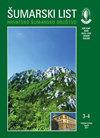2018年至2020年间,欧元区水稻(山猫)在克罗地亚的传播和最小种群。
IF 0.4
4区 农林科学
Q4 FORESTRY
引用次数: 3
摘要
关于濒危物种分布和丰度的科学数据是对其进行有效保护和管理的基础。在本文中,我们介绍了克罗地亚首次基于科学的山猫种群规模估计结果。这项研究的目标是确定2018年至2020年期间克罗地亚山猫的分布区域,并估计其最小数量。为了确定山猫的分布,从2018年5月初到2020年4月底,共收集了902个山猫存在的迹象。其中,92.8%的山猫观察结果被归类为C1,2.8%被归类为C2,4.4%被归类为C3。Primorsko–Goranska和Ličko–Senjska县、Karlovac县南部和Zadar县东北部的总面积为7200平方公里,确认了山猫的永久存在。对于最小种群规模的估计,804张相机捕捉到的照片识别出89-108只成年山猫。在108只已确认的个体中,有29只雌性,22只雄性,而7只动物的性别尚未确定。在这两个繁殖季节,我们拍摄了25窝44只幼崽的照片。山猫种群监测的未来重要步骤是纠正本研究中发现的缺陷,并实施方法,使我们能够使用空间捕获-再捕获模型来估计克罗地亚的山猫丰度。本文章由计算机程序翻译,如有差异,请以英文原文为准。
Rasprostranjenost i najmanja veličina populacije euroazijskog risa (Lynx lynx) u Hrvatskoj u razdoblju 2018.–2020.
Scientific data on distribution and abundance of endangered species are the foundation for their effective conservation and management. In this paper, we present results of the first scientifically – based estimation of lynx population size in Croatia. The goal of the study was to determine the area of lynx distribution and to estimate the minimum size of lynx population in Croatia in the period 2018 - 2020. To determine lynx distribution, 902 signs of lynx presence were collected in the period from the beginning of May 2018 until the end of April 2020. Out of those, 92.8% of lynx observations were categorized as C1, 2.8% as C2 and 4.4% as C3. Permanent lynx presence was confirmed in Primorsko – Goranska and Ličko – Senjska county, in southern part of Karlovac county and north-eastern part of Zadar county on the total surface of 7200 km2. For the minimum population size estimation, 804 camera trap photographs led to identification of 89 – 108 adult lynxes. Among 108 identified individuals there were 29 females, 22 males, while for 7 animals the sex was not determined. During the two reproductive seasons, we photographed 44 cubs in 25 litters. Future important steps in lynx population monitoring are correcting the deficiencies identified in this study and implementation of methodology that will allow us to use spatial capture recapture models for estimation of lynx abundance in Croatia.
求助全文
通过发布文献求助,成功后即可免费获取论文全文。
去求助
来源期刊

Sumarski List
FORESTRY-
CiteScore
0.90
自引率
20.00%
发文量
32
审稿时长
>12 weeks
期刊介绍:
Forestry Journal publishes scientific and specialist articles from the fields of forestry, forestry-related scientific branches, nature protection and wildlife management.
 求助内容:
求助内容: 应助结果提醒方式:
应助结果提醒方式:


